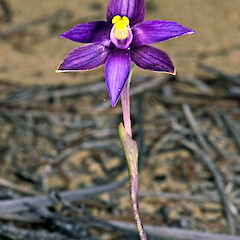Thelymitra matthewsii
Common name
spiral sun orchid
Synonyms
Thelymitra daltonii R.S.Rogers
Family
Orchidaceae
Flora category
Vascular – Native
Endemic taxon
No
Endemic genus
No
Endemic family
No
Structural class
Orchids
Current conservation status
The conservation status of all known New Zealand vascular plant taxa at the rank of species and below were reassessed in 2017 using the New Zealand Threat Classification System (NZTCS) – more information about this can be found on the NZTCS website. This report includes a statistical summary and brief notes on changes since 2012 and replaces all previous NZTCS lists for vascular plants.
Please note, threat classifications are often suggested by authors when publications fall between NZTCS assessment periods – an interim threat classification status has not been assessed by the NZTCS panel.
- Conservation status of New Zealand indigenous vascular plants, 2017 . 2018. Peter J. de Lange, Jeremy R. Rolfe, John W. Barkla, Shannel P. Courtney, Paul D. Champion, Leon R. Perrie, Sarah M. Beadel, Kerry A. Ford, Ilse Breitwieser, Ines Schönberger, Rowan Hindmarsh-Walls, Peter B. Heenan and Kate Ladley. Department of Conservation. Source: NZTCS and licensed by DOC for reuse under the Creative Commons Attribution 4.0 International licence.
2017 | Threatened – Nationally Critical | Qualifiers: EF, RR, TO
Previous conservation statuses
2012 | Threatened – Nationally Critical | Qualifiers: EF, RR, TO
2009 | Threatened – Nationally Critical | Qualifiers: EF, TO, RR
2004 | Non-resident Native – Coloniser
Distribution
Indigenous. New Zealand: North Island (locally present around Te Paki. It appears to be extinct at its original New Zealand location on sandhills between Ahipara and Kaitaia). Also Australia (South Australia and Victoria).
Habitat
Coastal to lowland (0–200 m a.s.l.) in open clay pans, on old semi-stablised but sparsely vegetated sand dunes and in open, ultramafic outwash and gullies. Also found on recently exposed soils and sand blow outs within shrubland. Requiring open sites, this species soon disappears when taller plants invade its habitat.
Detailed description
Terrestrial orchid up to 150 mm tall occurring as single plants or in small groups of up to 10 individuals. Leaves of three types; those of seedlings to juveniles 5–10 mm long, solitary, flexuous, not twisted, apex hooked; those of subadults 10–30 mm long, narrow of uniform width, spirally twisted, apex not hooked; those of mature plants 30–80 mm, broader at base, tapering, mostly linear, spirally twisted around stem, apex not hooked; sheath of adult leaves broad, finely puberulent, dark green to glaucous-green. Stem puberulent at base, terete, dark green to glaucous green. Inflorescence 1–(2)-flowered. Perianth 8–14 mm long, very dark purple-blue with darker veins. Sepals, petals and labellum alike, lanceolate to oblong-lanceolate, acute to shortly acuminate. Column short; anther exposed; connective prolonged; column arms more or less oblong, thick, fleshy; neither lobed nor ciliate, bright yellow; post-anther lobe absent; small calli occasionally present across back of anther between bases of column arms. Capsule broadly ovoid 10–15 mm long.
Manaaki Whenua Online Interactive Key
Similar taxa
A very distinctive orchid quite unlike any other indigenous New Zealand Thelymitra J.R.Forst. et G.Forst. The spirally twisted adult leaf through which the flowering stem protrudes is unique to this species in New Zealand, while the absence of a post-anther lobe is shared only with the quite unrelated T. cyanea (Lindl.) Benth., which can be immediately distinguished from T. matthewsii by its requirement for acidic wetlands, absence of a spirally twisted leaf, and ribbon-like, spirally twisted rather than erect and fleshy column arms. No other Thelymitra in New Zealand has such deep purple (almost purple-magenta) flowers as T. matthewsii.
Flowering
(July)–September–(October)
Flower colours
Blue, Violet/Purple
Fruiting
September–December
Propagation technique
Difficult—should not be removed from the wild,
Threats
Habitat loss and plant collectors have been the main cause for the decline and extinction of this species at its original New Zealand sites. It was rediscovered in the late 1980s in what are largely secure reserved sites. However, even there weeds such as Hakea spp. are a constant threat. It is also very vulnerable to trampling as it prefers open, somewhat unstable, erosion-prone soils. In Australia it is regarded as threatened (at least Vulnerable) and may be extinct in South Australia.
Etymology
thelymitra: Woman’s hat
matthewsii: After Mathews
Where To Buy
Not commercially available.
Notes on taxonomy
As of 2004 APNI list Thelymitra matthewsii as a synonym of the highly variable Australian T. spiralis (Lindl.) F.Muell. This decision is disputed by J. Jeanes (MEL) who is revising the genus. Jeans maintains that T. matthewsii is distinct from T. spiralis. NZPCN follows his advice but further research is desired.
Attribution
Description adapted from Moore and Edgar (1970).
References and further reading
Moore LB, Edgar E. 1970. Flora of New Zealand, Volume II. Indigenous Tracheophyta: Monocotyledones except Gramineae. Government Printer, Wellington, NZ. 354 p.
Rolfe JR, de Lange PJ. 2010. Illustrated guide to New Zealand sun orchids, Thelymitra (Orchidaceae). Jeremy Rolfe, Wellington, NZ. 57 p.



















